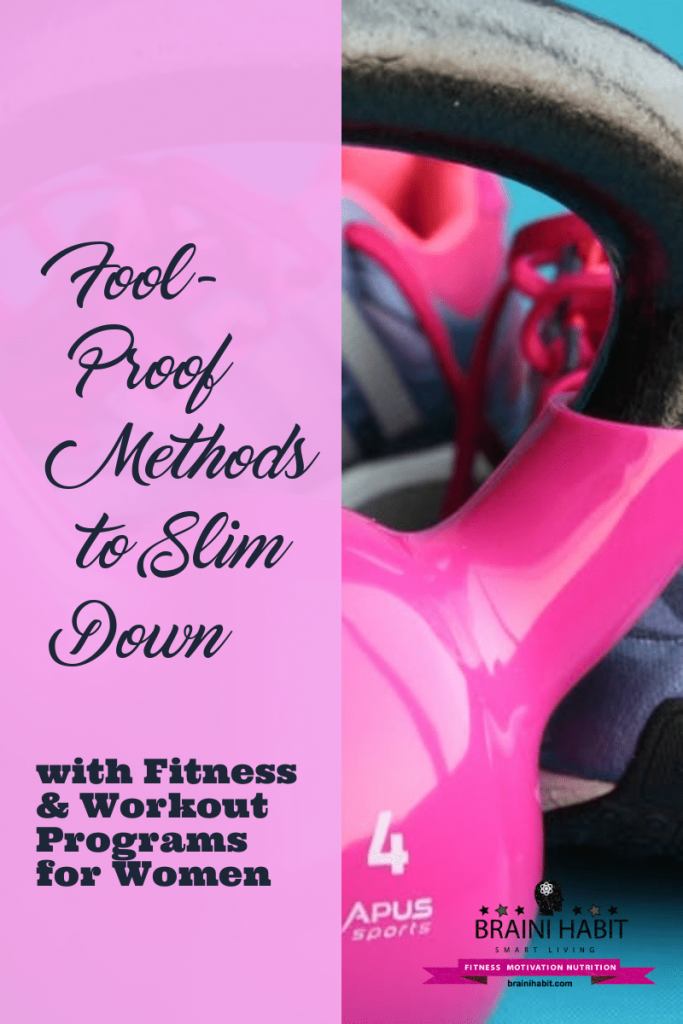What we want to begin with, is the only factor needed for weight-loss – a caloric deficit.
Science is conclusive – reducing energy intake is the most important condition to lose weight (1).
However, every guideline for a healthy lifestyle and fat-loss recommends a combination of diet with exercise. And with good reason – there are multiple health benefits of higher physical activity.
To allow a wider variety of foods, we need to increase the calories consumed, respectively we need help burning more calories. Too much calorie-restrictive diet can lead to deficiencies.
In this article, we are going to explain the benefits of adding physical activity and how to optimize them. We have two main options – cardio or resistance training.

- Cardio or weights is better for slimming down?
- Resistance training for women is best
- How to make your workout program
- Main training principles you should understand
- Choosing the proper exercises for you
- How to train your abs most effectively
- Best glute builder for a great summer body
- Resistance Training around your menstrual cycle
- The bottom line for optimal weight loss
Cardio or weights is better for slimming down?
While long sessions of cardio might burn more calories compared to resistance training and create a bigger caloric deficit – thus lose weight faster (2), this weight loss might turn out to be short-lived.
Regular cardio training leads to quick mitochondrial adaptation, making it less and less effective.
A study showed that to maintain the same weight, endurance training has to be increased by 4.4 km/week annually in men and 6.2 km/week annually in women (3).
The problem with cardio is that it can lead to a chronic increase in the stress levels in the organism.
A study shows that after either high or low-intensity cardio there is an increased level of stress and need for antioxidants (4).
Another study shows that these repetitive increases in stress after endurance training might lead to a chronic elevation (5).
Because of the increases in stress and the lack of muscle-building stimulus, a portion of the lost weight might not be fat, but muscle (6).
We have to keep muscle tissue as much as possible because it is the main contributor to the ‘toned’, ‘fitness’ aesthetic look and it drives our metabolism.
Muscle tissue metabolism burns almost 3 times more energy than fat tissue even when resting (7).
Losing muscle reduces our metabolic rate, making us more likely to suffer from the yo-yo effect and regain fat.
What allows us to preserve our muscle and even stimulates its hypertrophy is resistance exercises.
Evidence suggests that developing muscle, strength, and endurance boosts greatly general health and fitness (8).
The adaptation caused by resistance training increases our basic metabolic rate and causes our bodies to slowly but progressively burn more calories.
Take-Away:
Resistance training is better than cardio for long-term fat loss and developing an aesthetic body because it helps in increasing our basic metabolic rate.
Resistance training for women is best
While resistance training is quite popular among men, women are much more conservative about it and prefer sticking to cardio.
One of the reasons is that the ladies are worried about getting too muscular. Men and women indeed have similar potential for building muscle and strength according to evidence (9)(10).
However, females start with a much lower amount of muscle in the first place and also lack sufficient amounts of testosterone to achieve significant hypertrophy. This makes building muscle much slower and harder process.
Specific training, strict regimes, proper nutrition, and even the use of steroids, all combined is needed for women to practically achieve bulky musculature.
A study showed that in normal conditions, males build muscle much faster compared to females (11).
The above study also shows that while women build muscle much slower, they also lose muscle mass much more slowly.
Another study shows that this effect might be due to the presence of estrogen (12).
Estrogen has strong antioxidant properties, reduces muscle damage and stabilizes muscle cell membranes. This makes women much more resistant to overtraining.
Evidence shows that ladies also fatigue slower than men during isometric muscle contractions (13). This might be due to better neuromuscular performance.
This resistance to muscle loss and fatigue might potentially allow women to train with longer sessions than men, with shorter rest periods, and higher weekly frequency.
Take-Away:
Resistance training is quite suitable for women since their physiology allows them to train longer and much more often, without risking muscle loss.
How to make your workout program
When first starting resistance training, it is much easier using an already composed training program as a basis. However, a few things have to be considered.
The best workout program is an individualized one, suitable for your schedule and lifestyle so that it optimizes recovery and ensures steady progression.
This means that once you start your journey in resistance training, any basic routine has to be tweaked to fit your personal characteristics.
The best starting point for females is high-frequency training, which aims to train every body part at least two to three times per week.
A meta-analysis of ten studies shows that for both males and females higher frequency training leads to better results (14).
For this frequency, an upper-lower or full-body split is going to be most suitable, depending on personal preferences and schedules.
For ladies with a busy schedule even two full-body workout sessions per week at a minimum, in a combination with caloric restriction can be effective to slim down.
This type of higher frequency training means implementing just one or two exercises per muscle in a single workout session, instead of dedicating the whole training to one area and targeting it with 4-5 or sometimes more exercises.
Take-Away:
For both men and women it is more suitable to train each muscle group at least twice per week, and split the volume amongst the training sessions.
Main training principles you should understand
Some of the most important terms and principles in resistance training are training volume, training intensity, supersets, deloads, and progressive overload.
Training volume is the amount of sets and reps done, while intensity is what we call the weight used.
Logically, the more intensity we apply in our training routine, the less volume we can implement – the heavier the weight, the fewer the reps.
For women, the general recommendation is training in a slightly higher rep range while using slightly lighter weight – 8 to 15 reps per set.
Because of the effects of estrogen training in higher rep ranges and applying more volume does not cause so much muscle damage and protects against muscle loss.
Estrogen also allows for shorter rest periods which is quite suitable for implementing supersets. Supersets are combinations of exercises performed together, consecutively, set by set.
Supersets may make the workout feel harder, more straining, but also shortens the time spent in the gym and allows you a more flexible schedule.
Progressive overload is another key principle in resistance training. The goal of this principle is to slightly increase the work done in the gym every week.
Science has determined that progressively increasing the volume and intensity is the main driver for progress in resistance training individuals for both men and women (15).
This can be achieved by adding very small amounts of weight to your heaviest compound exercises, for each muscle group every week or every few workouts – usually, the smallest weights in most gyms are 1.25 kg.
Deloading is an important concept in resistance training. Because of progressive overloading which is essential for reaching your goals, fatigue also accumulates over time.
At some point, it is better to reduce both volume and intensity significantly for a whole week, to be able to continue progressing after.
This allows for much better recovery and steadier progression, without hitting a plateau.
Take-Away:
The main principles for progress in resistance training are slowly increasing the volume and intensity of training over long periods while incorporating regular deloads to boost recovery.
Choosing the proper exercises for you
A lot of people when picking their exercises to slim down and lose fat, choose mostly abs exercises, trying to burn the belly fat specifically.
However, research so far does not confirm that you can target the burning of fat with exercise of specific areas (16)(17).
Your own unique body and physiology determine which areas to use first for fat supply, and all we can do is simply put ourselves in a caloric deficit to burn that fat.
This is why we need a combination of exercises that burns the most amount of calories.
Free weights (dumbbells and barbells) allow a greater range of motion and more muscle activation, so they are the way to go.
They should always be preferred in comparison to machines unless the person has muscle or joint impairments.
Studies show that they lead to better muscular development (18). However, remember to always start with light weights and learn proper technique first.
Generally, we can also divide exercises into isolation movements and compound movements.
Compound exercises involve movements in at least two separate joints and train more than one muscle.
They should be the main building blocks of our training program routine as they burn the most amount of fat and stimulate more muscles at once.
Isolation exercises involve usually only one joint and train actively mostly just a single muscle. They can be used as complementary exercises.
It is very important, no matter what exercises you choose, to not limit your range of motion.
According to science, performing exercises in a full range of motion is best to optimize the positive effects of training (19).
Of course, the range of motion will vary from person to person, and for people with severe obesity or muscle and joint problems, it should be more sparing.
Take-Away:
According to science, it is better to use free weights and train through a full range of motion.
How to train your abs most effectively
As we already mentioned, to slim down and make the abs more visible, we cannot burn fat from certain areas specifically. We need to burn more fat in general by using various exercises.
The squat is a great example that fits perfectly into any routine not only as a leg exercise.
Because our core has the function of keeping us upright, studies confirm that squat and other compound exercises are great for also targeting the core muscles, which includes our abdominal muscles (20).
However, we also have evidence showing that compound movement does not target specifically the rectus abdominis – the muscle that gives abs their shape, or the obliques – the side ab muscles (21)(22).
This means that incorporating abs specific exercises like planks and crunches might still provide some benefits.
However, in order not to affect your performance in the compound movements, it is better to perform those exercises not too often and at the end of the workout. Using a moderate rep range of 8 to 12 is also optimal.
Some concerns that have been previously raised about crunches and increased risk of lower back injury are not supported by science at all (23).
A good combination would be alternating between crunches and planks since planks are great not only for abs development but core stability too.
If planks are too easy for you and you can hold them for more than a minute or two, some variations can make the exercise better.
To make the plank more effective, according to science, you can put your elbows on the ground slightly in front of your shoulders and closer together, and squeeze your glutes while focusing on keeping your body straight. (24).
A popular trend, especially in Crossfit is training with BOSU balls or other methods creating instability.
However, there is no increased muscle activation when training with added instability, according to evidence, while the risk of injury increases (25).
Take-Away:
It is optimal to stick to compound movements and add small amounts of accessory ab work, without overtraining.
Best glute builder for a great summer body
Evidence suggests that it might be optimal to begin your glute training session using a pre-activation exercise (26).
The concept of pre-activation is to help you feel the muscle and aid your mind-muscle connection before you start with your main exercise (27).
One of the most suitable ways to pre-activate this muscle group is using elastic bands.
A great example is the band side walk, where you put an elastic band around both of your legs at the knee level or lower.
After that, the workout session can continue with the main movement targeting the glutes.
A lot of people choose that movement to be the squat. However, science suggests otherwise.
The squat is a great compound movement, which targets many muscle groups simultaneously and leads to great overall lower body development.
It rightfully can be named the king of all exercises and definitely should be incorporated in every training routine.
However, compelling evidence shows that squats are better for quad activation, rather than glute activation (28). In this particular study, hip trusts resulted in better glute engagement.
The glutes are generally engaged the most when they are in position as in hip trusts (29).
Overall science suggests that a combination of pre-activation exercise, followed by a hip trust might be optimal for stimulating glute development.
For glutes, it is also most optimal to train them at least 2-3 times per week (30).
Since we are training with a higher frequency, we can fit also other exercises throughout the week like glute bridges, walking lunges, and hip extensions.
Take-Away:
The best exercise for targeting the glutes is the hip trust, while squats lead to greater development of the quadriceps. Pre-activation might be added for optimal effect.
Resistance Training around your menstrual cycle
To explain the principles of training around a menstrual cycle, first, we have to go over the basic hormonal changes and phases during the 4 weeks period.
The menstrual cycle begins with bleeding which marks the first day of the follicular phase. At this point both estrogen and progesterone are low.
The levels of estrogen start increasing from the beginning of the follicular phase and spike towards the end of the second week when the ovulation occurs.
After the ovulation, during the third week begins the luteal phase. Estrogen levels are still high, but the levels of progesterone also start to increase.
Because of the increase in progesterone during the fourth week, levels of hunger start to increase (31)(32).
Towards the end of the fourth-week estrogen and progesterone, both decrease and bleeding occurs again – the cycle begins anew.
During the first two-three days when the bleeding is more intensive, if there are abdominal pain and cramping, training should be avoided.
Afterward, studies show that during these first two weeks when the follicular phase occurs is most optimal to train more intensively (33)(34).
Our recommendation is to focus on compound exercises that can be done with relatively heavy weight for 6-10 repetitions.
Around the second and third weeks, when ovulation occurs training volume can be progressively increased, using 10-15 repetitions.
During the fourth week when the hormones start decreasing, it is a good time to reduce the weights and make a deload.
Take-away:
Studies show that it is better to train harder during the first weeks of your menstrual cycle and reduce the weight and volume during the last week.
The bottom line for optimal weight loss
To summarize everything up, combining diet with resistance exercise is the most effective way to slim down and keep your progress.
While men have been doing this for a long time, resistance training can be just as suitable for women too.
The most important thing is for the routine to be individualized in terms of volume, intensity, frequency and exercise choices, while also taking into consideration personal schedules and the menstrual cycle.
The most effective workout program for you is the one that gives you steady and sustainable progress.





